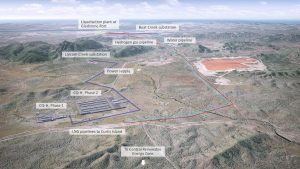Could Queensland export sun and wind to Japan?
The dream of shipping the Sunshine State’s abundant renewable energy resources in the form of hydrogen has passed an important test.

Exports of zero-emissions hydrogen, produced from renewable energy sources, are both technically and, potentially, commercially feasible according to a new study.
The Central Queensland Hydrogen Project Feasibility Study concludes a large-scale green hydrogen project in the Gladstone Region in Central Queensland could help launch a new low-carbon export industry for Australia.
The Central Queensland Hydrogen Project (CQ-H2) could also underpin a renewable hydrogen hub in the industrial heart of Gladstone.
Part funded with $2.16 million from ARENA, the $10.4 million CQ-H2 study examines the case for developing a large-scale renewable hydrogen supply chain from Gladstone to Japan.
The project would include a large scale hydrogen production facility near Gladstone and a hydrogen liquefaction facility at the Port of Gladstone.
The study considers export figures of up to 268,000 tonnes of hydrogen by 2031. It forecasts an initial green hydrogen production cost of $4.89 /kg, falling to $2.79 /kg by the early 2030s with additional scale up.
Hydrogen processing and transport costs are expected to equal around $3.00 /kg at ultimate scale.
A consortium of six companies, led by Queensland energy generation business Stanwell Corporation, conducted the study.
The Consortium is now undertaking further work and intends to proceed to Front End Engineering and Design, subject to Consortium partners approval, in 2023.
Why Central Queensland?

According to the report: “Gladstone provides the ideal location for developing a liquefied hydrogen export project.”
The region’s existing industrial base means Central Queensland already possesses extensive utility, road, rail and port infrastructure. Plus, suitable land availability to support development of renewable hydrogen projects.
Central Queensland is also rapidly developing the hydrogen supply chain that will be necessary to support large-scale hydrogen production and export projects.
The region boasts a natural deep-water port and has a history of international trade and proximity to key export partners such as Japan, Korea, China and India.
And, last but not least, Queensland has world-leading solar and wind energy resources to supply power to the project.
Why Japan?
The report says the CQ-H2 Project offtake is “predicated on the export market supply arrangements with hydrogen end users and refuelling companies in Japan.”
Japan has since 2014 targeted a transition to becoming a hydrogen-based society. And in 2017, Japan created its world leading Basic Hydrogen Strategy.
Japan’s Green Growth Strategy Through Achieving Carbon Neutrality in 2050 promotes a national push towards a hydrogen future.
Renewable hydrogen is expected to play a major role in Japanese transport, business and household energy needs. It will also replace fossil fuel-derived hydrogen as an industrial feedstock.
Under the Green Growth Strategy plan, Japan intends to expand its hydrogen market. Current usage stands at two million tonnes per year, rising to around 20 million tonnes by 2050.
Six consortium partners
Stanwell Corporation is a Queensland Government-owned corporation and lead sponsor of the CQ-H2 Project. Stanwell provides of electricity to Queensland, the National Electricity Market, and large energy customers along Australia’s eastern seaboard.
Iwatani Corporation is an industrial gases company and Japan’s largest hydrogen supplier. Iwatani initiated operations at Japan’s first commercial liquefied hydrogen plant in 1978 and built the first liquid hydrogen plant in Osaka in 2006. It has since built a comprehensive nationwide hydrogen network ranging from production to transport, storage, supply, and security.
Marubeni Corporation is the fifth largest general trading company in Japan. It supplies products and services spread across a broad range of sectors including LNG, power projects and infrastructure.
Kansai Electric Power Company Incorporated (KEPCO) is the second-largest electric power company in Japan. KEPCO’s Zero Carbon Vision 2050 emphasises the importance of accelerating the adoption of new technologies, including hydrogen, ammonia,
Kawasaki Heavy Industries Limited (KHI) is a world leader in the production, storage, shipping and handling of liquid hydrogen.
Rounding off the six is Australia’s APA Group (APA), a leading energy infrastructure business. APA is one of Australia’s largest owners and operators of renewable power generation assets.
LIKE THIS STORY? SIGN UP TO OUR NEWSLETTER

ARENA